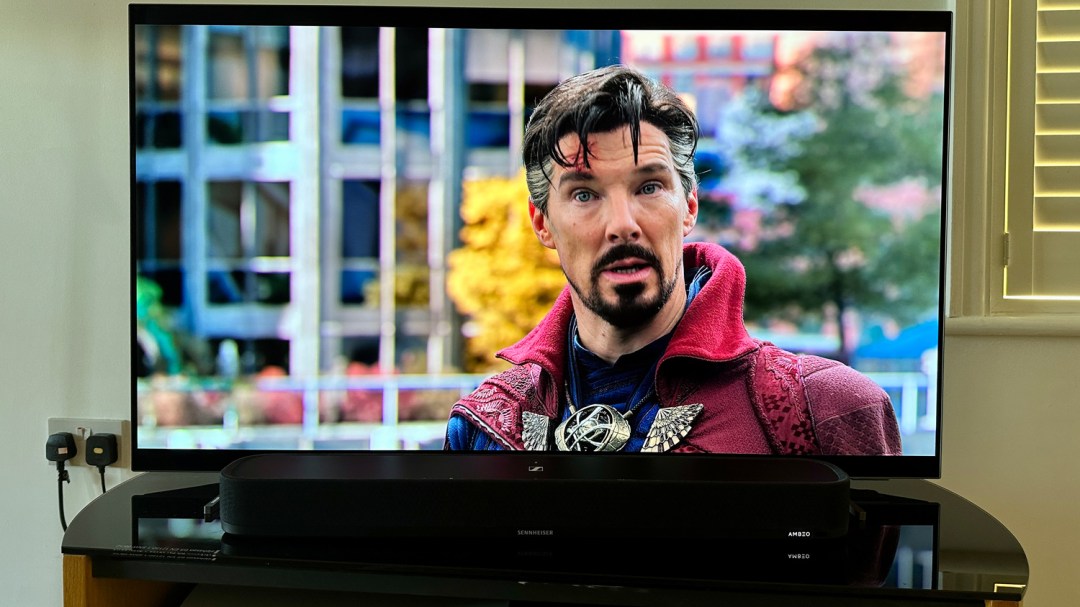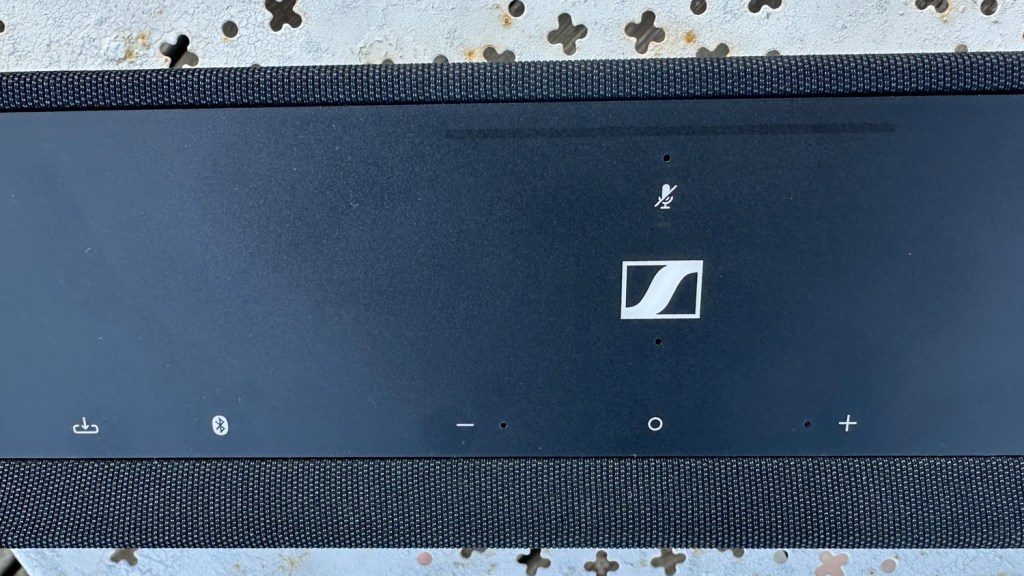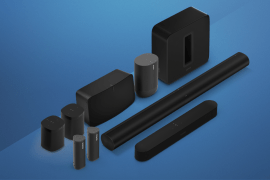Sennheiser Ambeo Mini review: small size, mighty sound
Sennheiser shrinks its epic Ambeo soundbar, while keeping much of what made the original great

Having dominated the ‘soundbar the size of tank’ market with its Atmos-enabled Ambeo soundbar, by way of an encore Sennheiser launched the Ambeo Plus – which turned out to be one of the best ‘quite big, quite expensive’ soundbars around. And now there’s the Ambeo Mini – to no one’s surprise, it’s the smallest of the range, but that doesn’t mean it’s short of ambition.
There’s a new compact-yet-premium, kind-of Dolby Atmos soundbar in town. But is it any good?
Design and build: imitation and flattery


If you hadn’t already got an eyeful of the price of the Ambeo Mini, you might think Sennheiser had designed it to go head-to-head with the Sonos Beam Gen 2. After all, its 65x700x100mm dimensions are almost identical, and the way it’s rounded off at either end is more than a little reminiscent too.
Elsewhere, though, the design is Sennheiser all the way. The Ambeo Mini looks quite a lot like a – hey! – miniature version of the Ambeo Plus we reviewed (and loved) a while back. It’s got the same combination of high-quality plastic and acoustic cloth wrapped all the way around it. It’s got the same slope to its top panel that creates a lip at the front end. It’s available in the same finish: black, with black accents. And it’s got the same sort of unburstable build quality, the same sensation of a product that’s been screwed together to the point it should last for decades.
Which, when you remember how much Sennheiser wants for this little soundbar, is really just as it should be.
Features: all channels open


Unlike its bigger, more expensive Ambeo siblings, the Mini doesn’t have physical speaker drivers attempting to create a sensation of sonic height as part of a spatial audio presentation. Instead, the Ambeo Mini uses virtualisation technology (developed jointly by Sennheiser and Fraunhofer) in an effort to allow its six speaker drivers to kid you into thinking you’re listening to a full-on 7.1.4 -channel soundtrack.
Four of those six drivers are 38mm full-range numbers. Two face forwards from behind the acoustic cloth, and generate the left, right and centre channels, while there’s another at each of the soundbar where they attempt to create some sonic width. The other two are 102mm bass drivers, and they fire from behind the plastic of the top panel to deliver the sort of low-end grunt that Sennheiser reckons translates to a reach down to 43Hz.
All six drivers are made of cellulose, and all six contribute to the virtualisation algorithm that’s trying to create the ‘top’ effects that are the USP of spatial audio (and that’s spatial audio of all popular types – as well as Dolby Atmos, the Ambeo Mini is compatible with 360 Reality Audio, MPEG-H and DTS:X). They’re powered by a total of 250 watts of Class D amplification.
Getting your audio information on board can be done in a number of different ways. Wireless connectivity runs to wi-fi and Bluetooth 5.0 (with SBC and AAC codec compatibility), and the Mini is compatible with Apple AirPlay 2, Chromecast, Spotify Connect, TIDAL Connect and UPnP – AirPlay 2 and Chromecast mean the Sennheiser can easily slot into a multi-room system, of course. There are a couple of physical connections in a little recess at the rear of the soundbar, too: HDMI eARC and a USB-A slot. Apart from mains power, that’s your lot – no sign of the HDMI passthrough you might have been hoping for (or just basically expecting, in light of the asking price).
Interface: make your choice




Sennehiser has made the effort here, no two ways about it. Interacting with your Ambeo Mini couldn’t be simpler, and there couldn’t really be more choice in the way you get to do it.
It’s probably easiest to use the ‘Smart Connect’ control app that’s free for iOS and Android. Not only does this put you in charge of all the obvious stuff like input selection and volume level, but it allows you turn the Ambeo virtualisation routine on or off, check for software updates, and access whichever of its six EQ presets (movie, music, adaptive and so on) is most appropriate for the content you’re watching. But first and foremost, it’s where you control the Ambeo Mini’s automated room calibration system – once the soundbar is in position, run the programme and keep nice and quiet while the test-tones do their thing. There are four far-field mics embedded in the top surface of the Mini, and after they’ve listened to the tone-bursts the Sennehsier sets itself to best suit the specifics of the room in which you’ve positioned it.
Those mics also look after voice-control. Amazon Alexa is built into the Ambeo Mini, but if you’re more of a Google Assistant sort of person you can control it this way instead – as long as there’s an appropriate smart speaker on a common network. You can defeat the mics altogether if you like – there’s a mute control on the top of the soundbar, along with a few other controls dealing with major functions and an LED strip that indicates volume level.
Of course, you might prefer the old-school charms of a remote control handset. The one provided here could use some backlighting, it’s true, and the font labelling the buttons is authentically tiny – but it’s a full-size, sturdy item rather than the flimsy credit card-style clicker that some alternative designs serve up.
Performance: not so much a dome, more a pyramid

If you’re the kind of madly optimistic person who’s expecting full-on overhead spatial audio sound from this modestly sized soundbar, you’re going to be disappointed. Keep your expectations realistic, though, and the Ambeo Mini is a straightforward pleasure to listen to.
It certainly generates deep, substantial and beautifully controlled bass. This is a little soundbar, don’t forget – yet it punches way above its weight, and manages to give its low frequencies plenty of detail and variation to go along with their substance. Sennheiser is pleased to tell you that the Ambeo Mini can support as many as four wireless subwoofers – but unless you live in a barn, it seems unlikely you’ll hear the need.
The Sennheiser keeps a firm grip on the bass stuff, which means there’s plenty of space for the midrange to do its thing. The centre channel in particular sees a lot of action in any movie soundtrack, and here dialogue projects well – so it’s easy to hear how loaded with detail and nuance it is, and how rounded and neutral in its tonality. The top of the frequency range, meanwhile, is equally detail-heavy, and remarkably crisp when you remember there are no actual tweeters involved here.
There’s plenty of dynamism to be heard, too, so the shift from ‘dead quiet’ to ‘bloody loud’ is both rapid and pronounced. And when it comes to soundstaging, the Sennheiser keeps a firm grip on proceedings – so while it creates a very wide, commendably deep stage, everything has a little space in which to operate and effects have a lot of room in which to travel.
In all honesty, there isn’t a huge amount of sonic height to the sound the Sennheiser generates, even when it’s given the show-off Dolby Atmos soundtrack to Nope to deal with. There are limits, it seems, to what the Ambeo virtualisation technology can achieve. So while there’s admirable width to the sound, the relative lack of height means that the Ambeo Mini doesn’t create a dome of sound as much as it creates a pyramid. It almost goes without saying that it’s an impressive performance given the compact nature of this soundbar and its lack of dedicated spatial audio drivers – but the same money spent on an (inevitably quite a lot larger) Dolby Atmos soundbar will give more overt results where height is concerned.
Change content to some Dolby Atmos music from the ever-increasing catalogue on TIDAL (Tumbling Dice by Little Dragon, day) and it’s a very similar story. The Ambeo Mini is organised and controlled, keeps rhythms natural and momentum high thanks to its low-end authority, and allows vocalists to express themselves fully. The sound is big and expansive, with a modest amount of height to it – ‘immersive’ is perhaps too strong a word, but the scale of sound that’s available here is out of all proportion to the soundbar’s, um, proportions.
Stereo music fares less well, though. With the Ambeo virtualisation technology switched on, there’s no lack of scale or spread to the sound of Eye Know by De La Soul – but there’s an obvious lack of focus and positivity to the presentation. Far better to switch the processing off – all the scale disappears, of course, replaced by a sound that’s about as big as the Ambeo Mini itself, but it’s far better focused and much less hazy.
Sennheiser Ambeo Mini verdict
The Sennheiser Ambeo Mini looks quite expensive for the amount of stuff your money buys – the same amount put the way of quite a few alternative brands will get you a bigger soundbar and maybe some rear speakers or even a wireless subwoofer. But if small means beautiful as far as you’re concerned, you won’t buy a bigger, punchier or more energetic sound from anything as compact as the Ambeo Mini.
Stuff Says…
Probably the biggest small soundbar you can buy
Pros
Detailed, widescreen sound
Great control options and good auto room calibration
More low-end punch than seems feasible
Cons
Not all that much ‘height’ to its sound
Has its limits when ‘virtualising’ music
Looks relatively expensive
Sennheiser Ambeo Mini technical specifications
| Speakers | 4x 38mm full-range, 2x 102mm bass drivers |
| Inputs | HDMI, USB-A |
| Connectivity | Bluetooth 5.0, Wi-Fi, AirPlay 2, Chromecast, Spotify Connect, Tidal Connect, UPnP |
| Dimensions | TBC |



